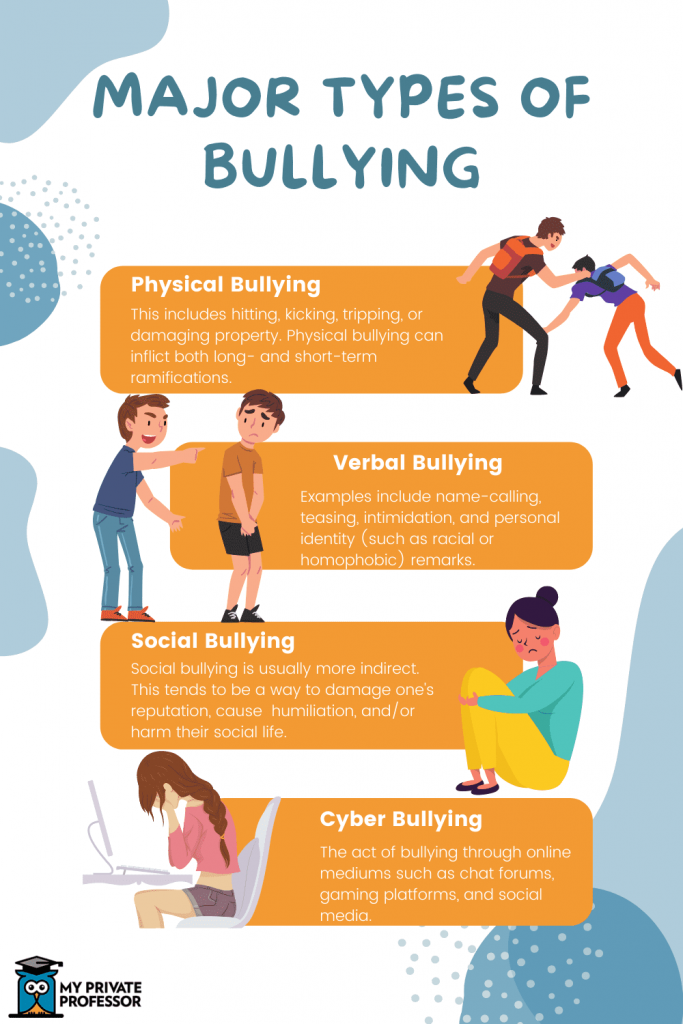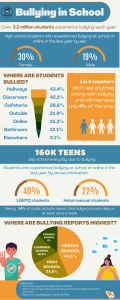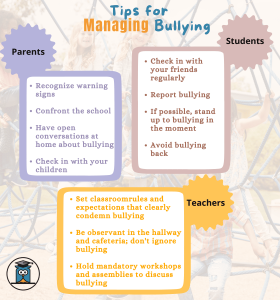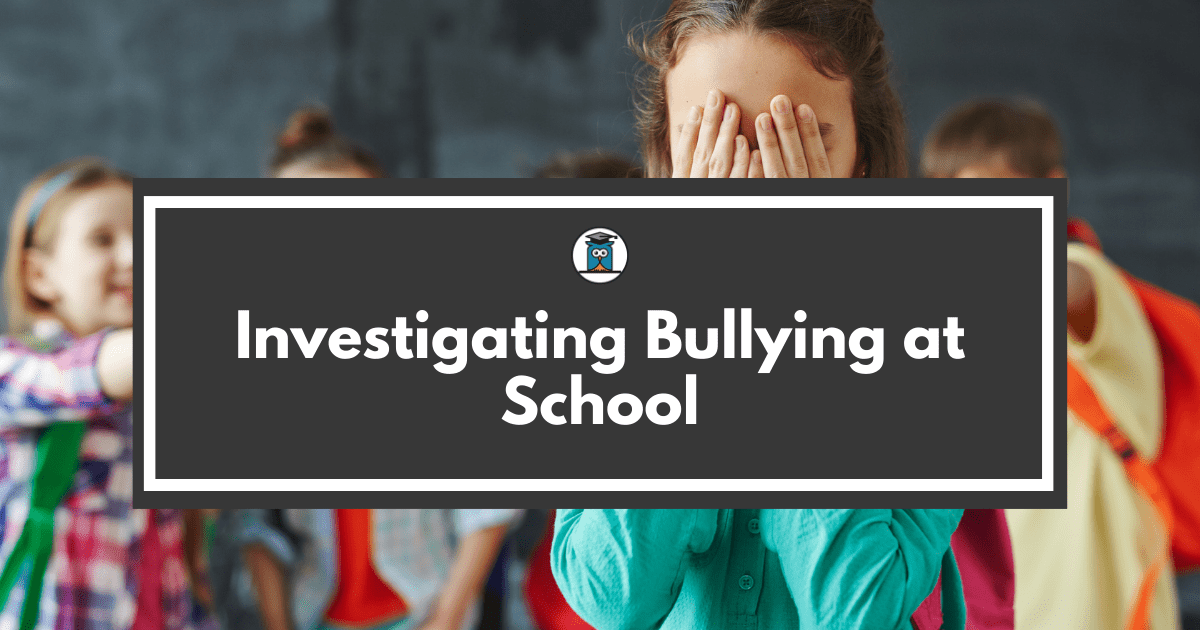In 2014, the CDC and Department of Education published the first federal definition of bullying.
This definition contains three key components:
- Unwelcome aggressive behavior
- Observed or perceived power disparity
- Repetition or high chance of repeated behaviors
How often does bullying occur in school?
Probably more often than you realize. And research points to just that.
The National Center for Education Statistics and the Bureau of Justice Statistics and the Centers for Disease Control and Prevention have published statistics that illustrate bullying’s pervasiveness:
- One in every five students (20%) of ages 12-18 has experienced bullying.
- Females (24%) slightly more frequently report being the target than males (17%).
- 41% of student victims to bullying reported that they thought it would happen again.
- Among different ethnicities, African-American students and Caucasian students report being bullied at school at the same rate (23%), while Asian students report being bullied at a lower rate (7%).
According to the National Center for Educational Statistics, as of 2016, 33% of students who reported being bullied in school indicated that they experienced it at least once or twice during the school year.
As of 2019, roughly 22% of students of ages 12 to 18 reported facing bullying during the school year. And while it’s a positive that this percentage has dropped, we still need to look at the incessant problem which affects students every day.
Comparitech surveyed over 1,000 parents with children older than age 5 around from 2018 to 2022. Their findings confirm that bullying remains widespread among adolescents, teenagers, and young adults, with the largest percentage of reports coming from parents with children of ages 14-18.
Direct vs. indirect bullying
Direct bullying
This form of bullying occurs between the bully & victim, and is usually overt. Examples include physical and verbal aggression or violence.
The National Bullying Prevention Center lists factors that establish direct bullying, including:
- Behavior is directed at victim
- Known bully identity
- Tangible evidence
Indirect bullying
On the flipside, indirect bullying is usually not overt, and tends to consist of administering psychological harm to the victim. Examples include excluding, spreading rumors/gossip, and spreading embarrassing or hurtful photos/videos of the victim on social media.
Typically, factors that establish indirect bullying include:
- Anonymous bully
- Concealed behavior
- Intent of isolating victim from peers
Cyberbullying
Cyberbullying may be indirect or direct. This occurs through virtual channels such as chat forums, messaging platforms, social media, gaming, and mobile phones. When someone engages in cyberbullying, they are usually aiming to scare, shame, or anger their target.
Examples of cyberbullying include:
- Spreading lies about victim on social media
- Posting embarrassing/harmful photos or videos
- Sending unkind, vicious, abusive, or threatening messages, photos, or videos
- Impersonating someone
It’s interesting to note that cyberbullying occurs more commonly between two friends rather than individuals who’ve never met. A 2018 study found that cyberbullying occurs between teens that know each other seven times more often than among people who had never been acquaintances.
How often does cyberbullying occur? According to the Cyberbullying Research Center, from 2007-2019, the percentage of individuals experiencing cyberbullying has doubled, (from roughly 18% to 36%).
When you consider how majorly technology and social media have grown in the last decade, this doesn’t seem all too surprising. More importantly, this growth in cyberbullying just points to the urgency of the issue and the need for more student support and action from educators, parents, authorities, and administrators. 
Why do people bully?
While there’s no one reason, there are a few common root causes.
Anger or frustration
In some instances, children and adults bully as a way of expressing their feelings toward their own problems such as issues at home or academic struggles. This often occurs when children don’t have the tools or necessary support to know how to express themselves appropriately.
Attention deficit
Another common reason is seeking attention—this typically occurs when children don’t feel as though they get enough attention at home, in school, or from their peers. In these instances, bullying is an attention-seeking behavior.
Low self-esteem
Sometimes, when people have insecurities about themselves, they turn their attention toward targeting and bullying someone else. This is often a mechanism that helps the bully deflect attention away from themselves.
Consequences of bullying
There are several consequences of bullying—and the specific consequences that arise depend on the nature of the bullying itself, & a number of personal/situational factors.
Mental health effects
Among the consequences of bullying are mental and emotional health impacts. When individuals experience bullying—whether over a long or short period of time—they tend to experience mental health consequences. & these consequences often aren’t temporary.
Research continually shows that continuous bullying lead the victim to experience depression, anxiety, and other adverse mental health effects.
Recently, a young boy in Utah died by suicide, a permanent ramification that constant bullying can yield. Drayke Hardman experienced repeated bullying over the school year—and though his parents continually checked on his mental health (even asking him whether he was having suicidal thoughts), Drayke ended his life on February 9th.
One study in Norway investigated long-term psychological effects of bullying on adolescents. The researchers found that all students who experienced bullying faced negative mental health outcomes through adulthood.
It’s important to note that the bullies also experienced adverse mental health outcomes. The study determined that both the victims and the bullies faced increased risk for hospitalization due to mental health disorders.
Physical impacts
If someone experiences bullying that includes physical violence/aggression, they may suffer injuries or various types of physical trauma, such as bruises or body pains.
While the above may be temporary, victims can also experience more long-term physical consequences of bullying. For instance, persistent bullying can lead to sleep disorders, chronic stomach aches, headaches, dizziness, and heart palpitations.
In addition, experiencing bullying can increase cortisol levels, which is something that often happens in conjunction with—or following—stressful events. This increased stress can then worsen the immune system and other hormone levels.
Academic consequences
A victim may often feel distraught, anxious, worried, frustrated, and/or distracted throughout the school day—so it’s unsurprising that this can lead to decreased academic performance.
In fact, research shows that frequent bullying is associated with lower grade averages and test scores, and is correlated with higher dropout rates and decreased academic performance.
How to address & prevent bullying
Teachers & educators
The school grounds are a hotbed for bullying, so it’s of the utmost importance that teachers and administrators promote a safe environment.
- Set classroom rules and expectations that explicitly prohibit any forms of bullying.
- Be observant in the classroom, hallways, cafeteria, and playground.
- Hold workshops and assemblies that provide students with comprehensive information about bullying and its consequences, and encourage students to share their experiences.
Parents
As a parent, you play a key role in supporting students and recognizing when your child might be having trouble at school. Below are some ways you can contribute to ensuring your child and other children are going to school feeling safe and happy.
- Recognize warning signs such as unexplainable injuries, difficulty sleeping, and self-destructive behaviors.
- Have open-communication with your children about bullying.
- Contact the school to address bullying.
Students
- Check in with your friends and confront them—alone and in a safe space— if you suspect they’re dealing with bullying.
- Report bullying when you see/hear about it.
- Take the high road and avoid bullying back.
Addressing bullying is a work-in-progress, so it’s important to act rather than sitting back and watching the issue unfold. Students, parents, educators, and communities can—and should—all take part in the movement to make the classroom a safe space for all students.
Author: Lydia Schapiro







